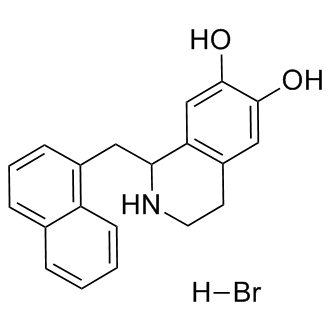| Cas No.: | 132836-42-1 |
| Chemical Name: | 1,2,3,4-Tetrahydro-1-(1-naphthalenylmethyl)-6,7-isoquinolinediol hydrobromide |
| Synonyms: | YS 49,Ys49 |
| SMILES: | C1CNC(C2=CC(=C(C=C21)O)O)CC3=CC=CC4=CC=CC=C43.Br |
| Formula: | C20H20BrNO2 |
| M.Wt: | 386.28 |
| Sotrage: | 2 years -20°C Powder, 2 weeks 4°C in DMSO, 6 months -80°C in DMSO |
| Description: | YS 49 inhibits Ang II-stimulated proliferation of VSMCs via induction of HO-1.YS-49 is a novel positive inotropic isoquinoline compound. YS-49 has potential as a therapeutic strategy for the pathogenesis of Ang II-related vascular diseases such as hypertension and atherosclerosis, via the induction of HO-1 gene activity. YS-49 induced HO-1 protein production in a dose-and time-dependent manner in VSMCs. Treatment with YS-49 significantly and dose-dependently inhibited Ang II-induced VSMC proliferation, ROS production, and phosphorylation of JNK, but not P38 MAP kinase or ERK1/2.YS-49(32.8 microM) exhibited much stronger inhibitory effects on TXA(2) formation. The higher inhibitory potencies of YS-49 (IC(50): 3.3microM) than higenamine (IC(50): 140 microM) on AA induced rat platelet aggregation was presumed to be the result of low inhibitory effect of higenamine than YS-49 on TXA(2) production from AA. The oral administration of YS-49 (50 mg/kg) increased the recovery rates from the acute thrombotic challenge in mice and lowered the weight of thrombus formed inside the AV shunt tube in rats. |

 To enhance service speed and avoid tariff delays, we've opened a US warehouse. All US orders ship directly from our US facility.
To enhance service speed and avoid tariff delays, we've opened a US warehouse. All US orders ship directly from our US facility.




















